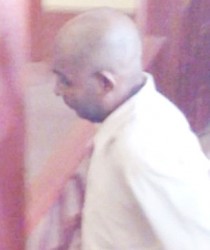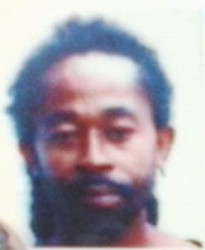Shawn Ravindra Ramai, who hit a cyclist and fled the scene then later told his employers that he had struck a horse, was yesterday sentenced to 60 months in jail after he was found guilty of causing death by dangerous driving.
In addition, Ramai, 36, of Lot 15 Norton Street, was also found guilty of failing to render assistance, failing to stop after the accident, and failing to report the accident within 24 hours of its occurrence, for which he was fined $30,000 on each charge.
Ramai, who was a Guyana Water Incorporated (GWI) driver at the time of the accident, was charged with driving pickup PRR 2923 in a dangerous manner and causing the death of 36-year-old Claude McPherson on February 26, on Mandela Avenue.

Following closing arguments by both the defence and the prosecution, Magistrate Judy Latchman told Ramai she found him guilty of the charges of causing death by dangerous driving, failure to render assistance to the victim, failure to stop and failure to report the accident.
In handing down the sentence, the magistrate took into consideration the number of deaths resulting from fatal accidents recorded at the ending of 2014.
After sentencing, defence attorney Fazil Azeez made an application for bail to be granted pending an appeal but Prosecutor Vishnu Hunt objected to bail on the ground that Ramai might not return to court.
The prosecution’s objection was subsequently upheld and Ramai was taken into custody.
Ramai had maintained his innocence throughout the trial, which saw 10 witnesses testifying.
Azeez, in his final submission, urged the court not to place any weight on the statement of an eyewitness who was in the vehicle at the time of the accident, since the witness was under the influence of alcohol. He also pointed to inconsistencies in the evidence presented by the witness and argued that it would be unfair to Ramai if the testimony was considered.
Azeez also questioned the work done by investigating rank, Constable Khemraj Narine, calling it “outrageous.”
“Once they have a person who they can tie to the event, that is where it ends,” he said, while arguing that the police found his client guilty long before he was brought to court.

Azeez urged the court to take the inconsistencies into consideration coupled with the fact that the CCTV footage, in which the accident was said to be captured, was not even brought to court as evidence although the rank had purportedly reviewed the video.
The accident, Azeez said, was unavoidable, since his client was exercising due care and concern.
Ramai’s story of him hitting a horse after the accident, counsel further argued, was told after he became confused and a result of his natural intuitive response to get out of a “tight spot,” like any normal human would.
The attorney also highlighted the stress the driver was under at the time of the accident, while also noting that he did later admit that he lied.
The fact that Ramai’s daughter was in the hospital at the time, combined with the fact that the confused man was thinking about losing his job, being the sole provider of his family, were all contributing factors, Azeez said, before adding that his client does not have a criminal mind.
He claimed that after the accident the driver did stop and offered to render assistance to the injured man but he was attacked by an angry mob, which prompted him to flee for fear of his life.
After the man fled, he reported to his workplace and later turned himself over to the police in the company of his attorney and has since cooperated with the investigation and was always punctual for his trial, Azeez stated.
According to Azeez, the evidence could fault his client because he did not report the accident immediately after and drove away although he sought to justify it by referring to the state of the human mind, which could become weak in such circumstances and make irrational decisions.
He said although the defence regrets the death, it was not a result of premeditation or reckless driving and the choice the driver took after the accident was an action any human could have taken.
Azeez then beseeched the court to impose a non-custodial sentence on his client should he be found guilty, while noting that his client is a father of three with an unblemished criminal record.
But Prosecutor Hunt dismissed the attorney’s submissions, while pointing out that the lawyer failed to create any doubt in the prosecution’s case.
Hunt explained that Ramai initially made denials in a statement and later changed his story but resorted to rely on the said denials in another statement.
Further, the prosecutor said that there was no doubt in the court that Ramai was the driver of the vehicle that was involved in the accident. However, he said the defence attempted to cast doubt on the manner in which the accident occurred and the events thereafter, while it wanted the court to believe that Ramai did everything within his power to avoid the accident. Despite Ramai’s six years of driving experience, he said, the man did not stop to render assistance as a prudent driver would have done. Moreover, he said Ramai refused to render assistance despite being urged by the other occupant of the vehicle.
In addition, Hunt said while the defence argued that Ramai was driving within the specified speed limit, other factors were excluded, including the condition of the wet road, the dark night and the amount of traffic on the road at the time. He also pointed out that Ramai admitted to driving a defective vehicle since he had indicated in his statement that he told his employer three weeks prior to the accident that the brakes were not working effectively.





